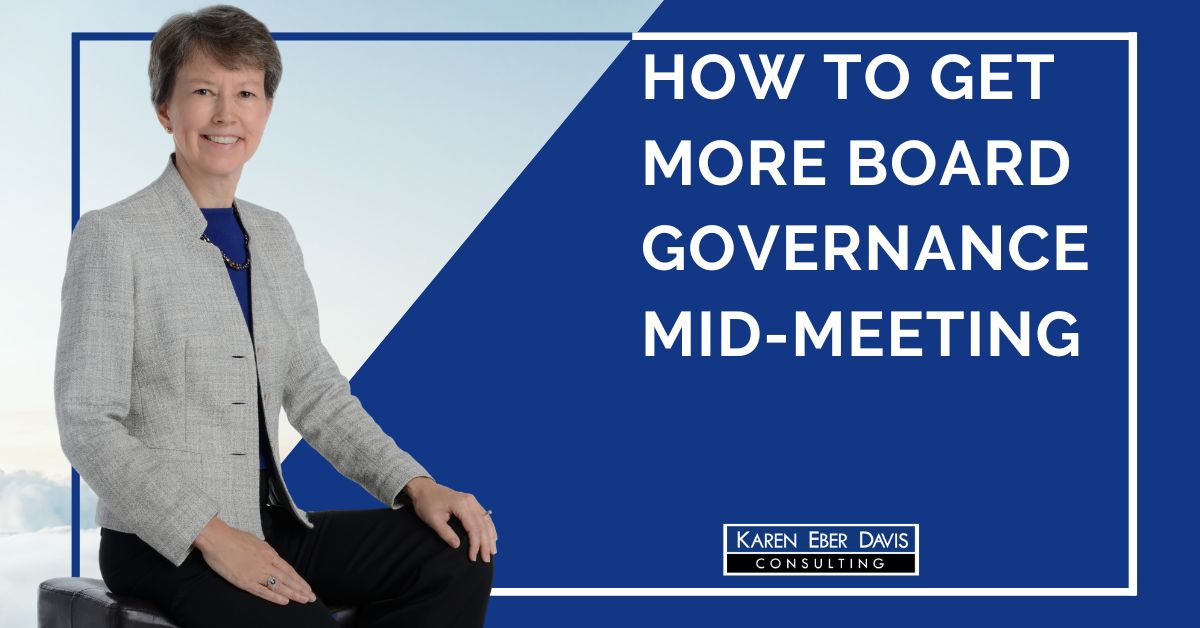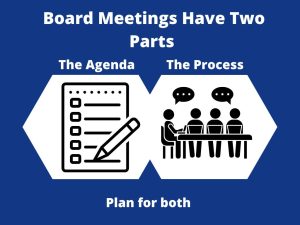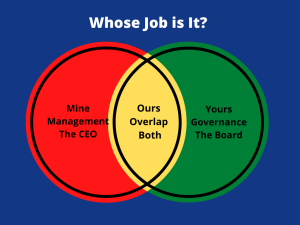
How To Get More Board Governance Mid-Meeting
Does your board ever slip into management issues and away from board governance mid-meeting? This video helps you to guide your board to stay focused on their board governance role and out of the management or micromanagement weeds IN MEETINGS. Board managing or micromanaging is a BIG pinch spot for nonprofit CEO. What can you do mid-meeting? In this video, you’ll learn three options for board tottering on overreach.
Note: This is a quick video with several mid-meeting options for board chairs and and nonprofit CEOS. You’ll love these options for when you need to steer back to governance mid-meeting.
Transcript of How To Get More Board Governance Mid-Meetings
Hi, I’m Karen Eber Davis, and this video is about helping your board to focus on governance and to avoid getting into the management or micro-management weeds in the middle of your board meetings. Ugh! Board managing or even micromanaging is a huge nightmare for nonprofit CEOs. I can feel the stress.
After all, the board is your boss, and it’s hard to get your boss to stay in their lane when it impinges on yours. The best thing, of course, is to prevent this. And stay to the end because I have a hint that talks about how to prevent it overall.
But right now, if you’re mid-meeting or about to go into one, you need some options, and that’s my goal here—to say you do have some options. You have some choices.
Your First Mid-Meeting Option for More Board Governance
Here’s your first option. Redirect them. It’s sort of like when you’re on the interstate, and there are those bumpers that remind you to stay in your lane. You’re just kind of bringing those back up and saying, “Hey folks, let’s let’s find the lane again.”
What’s it sound like? Here’s an example. “It’s been interesting to hear about the other special events, and that really ties right into the alcohol policy we want to consider. What are your thoughts about creating one?”
Where can you see it? Well, think about politicians and interviews. They often will say very interesting points about X, but that reminds me of Y. Let me tell you about that. And off they run.
So the heart of redirection is asking a question that’s a policy or strategy question. Usually, you’re going to affirm what’s already going on and try to finesse your way with that question.
Redirecting has some pluses and minuses. The pluses are it is subtle. It may just be all that your board needs. And the negatives are that it could be manipulative, i.e., think of the politicians. Or it could not be sufficient. It’s just a nudge, and they don’t get the hint, and they go back to the management in two minutes.
In which case, you might want to use the second option.
Meeting Anatomy
Before I delve into the second option that you have, I want to talk about the contents of meetings. Every meeting has two pieces. One is the actual agenda: the topics being discussed. The second is the process—how that meeting is working. That can be from who cues up the agenda items to whether we invite group discussions, to whether you vote. Whatever you’re going to do interactively about making those agenda items get on the agenda and get taken care of. That’s your process.
 Your Second Mid-Meeting Option for More Board Governance
Your Second Mid-Meeting Option for More Board Governance
So what you’re doing with this second option is observing behavior and talking about the process. So the heart is that you’re making a behavioral observation, and then you’re asking a process question.
Here’s what it sounds like. “Hey, we’ve used up about half of our allocated agenda time. Can you give me some feedback about if there’s a challenge with the agenda item or if we just need to get back on track?”
What is this like? It’s like the flashing light you see that tells you your speed when you’re driving. The speed zone sign tells you –Oh yeah, I’m going too fast, or I’m going right on track. It reminds you what your behavior is.
Where can you see this? Think about counseling or coaching relationships where the person says to you, hey, I’ve just noticed for the last fifteen minutes, you keep mentioning your brother.
So what are some drawbacks of this option? The first is it’s hard to be neutral when a board or someone is impinging on your territory and taking and impacting your role. So you might not be able to make that observation in a calm, clear non-emotional way.
Your Third Mid-Meeting Option for More Board Governance
So here’s the third option, and that is to actually name the problem, be curious, and get more information about what’s going on with your board and you on the table.
What’s it like? It’s sort of like when you’re in traffic at a light, and someone toots their horn ever so gently to remind you—like, oh, pay attention. Do something here.
It sounds like this. “This feels like a management or committee issue but not a board issue. What am I missing? Are there strategy or policy components here I’m not seeing?”
The heart of it is to say what the problem is, the challenge is ever so subtly or directly as is your style, and then asking a question that allows you to learn more and find out what it’s like from their side. And that listening and working towards solving with them has some real benefits. That is, it could really solve the problem. It can help you to know what they expect and what you expect from each other. And it can move your organization in a really solid way.
The challenge, of course, is that it may be like when you get tooted to that in traffic. Even if it is gentle, it annoys you, and the board is unhappy with you.
The Mid-Meeting Options
So those are your options for handling board management and micromanagement mid-meeting. I promised you a big hint. Here it is. Here’s a graphic that talks about Yours, Mine, and Ours.
 My hint is to use this graphic or your own that you create just like it. When you approach a topic with to the board chair and plan it and say okay, what part of this conversation is management? What part is board strategy and policy? And then where is their overlap?
My hint is to use this graphic or your own that you create just like it. When you approach a topic with to the board chair and plan it and say okay, what part of this conversation is management? What part is board strategy and policy? And then where is their overlap?
So that as you begin to discuss meetings, you have vocabulary about whether it’s yours (j.e., the boards), mine (the CEOs), or something we need to both have input ours. That kind of clarity that you built into your organization, the more you have of that, the less you’ll need to do anything besides redirect when the conversation runs amok in your board meeting.
You can help your board govern more and manage less. You have agency, power, and resources at your hand. Your board is there. They want to help. They want to do a good job. Help them to do so. Help them to see where the boundaries are and how you can work together to achieve the outcomes you want.
Before you go, like this video. Then send it on to your board chair and discuss how you together can both figure out how to help the board do more governing and less management and micromanagement in your board meetings. For more on how to promote board governance read, How to Move from an Operational to a Governance Board in 5 “Easy” Steps.
Karen Eber Davis is a nonprofit strategic planning consultant who works with visionary leaders committed to taking their organizations to new heights. She offers customized strategies, assessments, and coaching designed to help leaders lead their organizations to achieve their potential. She is the author of 7 Nonprofit Income Streams and Let's Raise Nonprofit Millions Together.
Categories
If you appreciate these Added Value posts, please consider subscribing.
Latest Posts
- The Uncertainty Vortex: How Visionary Nonprofit Leaders Move Forward Without Clarity
- How New Nonprofit CEOs Secure Board Buy-In for Strategic Planning
- How Nonprofit Leader Navigate Crisis with Clarity & Confidence
- One Way AI Can Help You Find a Path Where None Exists
- In Crisis? Resist Cutting Your Ability to Make Income
